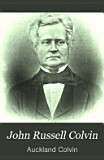John Russell Colvin
John Russell Colvin (29 May 1807 – 9 September 1857) was a British civil servant in India, part of the illustrious Anglo-Indian Colvin family. He was lieutenant-governor of the North-West Provinces of British India during the Indian Rebellion of 1857, at the height of which he died.

Biography

Colvin's was an Anglo-Indian family of Scottish descent. He was the second son and fourth child of James Colvin (born 1768), a merchant with Colvin, Bazett & Co. of London and Calcutta. He was educated at the East India Company College at Hertford Heath, Hertfordshire; and entered the service of the British East India Company in 1826.[2]
In 1836 he became private secretary to Lord Auckland at the time of the First Anglo-Afghan War of 1837, and named his son after him. From 1846-49, Colvin served as Commissioner of Tenasserim, in British (Lower) Burma.[2]

In 1853 Lord Dalhousie appointed him lieutenant-governor of the North-West Provinces of India. In 1857, at the start of the Indian Rebellion of 1857, Colvin was at Agra with only a weak British regiment and a native battery, not enough force to prevail against the mutineers. Colvin issued a proclamation to the 'natives' that was censured at the time for its clemency, but it was similar to the approach of Sir Henry Lawrence, later followed by Lord Canning. Colvin died shortly before the fall of Delhi.[2][lower-alpha 1]
Family

Colvin married Emma Sophia, daughter of Wetenhall Sneyd, a vicar in England; they had ten children,[3] many of whom continued the family connection with India. Bazett Wetenhall, Elliott Graham, and Walter Mytton all passed distinguished careers in India, and a fourth, Clement Sneyd, C.S.I., was secretary of the public works department of the India Office in London. The third son, Auckland, named after Lord Auckland, was lieutenant-governor of the North-West Provinces and Oudh, and also served in Egypt. He co-founded the Colvin Taluqdars' College in Lucknow; he also published a biography of his father in the Rulers of India series in 1895,[4] and in 1905 gave a stained glass East window to the church of St. Mary at Soham, both as a thanksgiving for the termination of the Second Boer War, and as a permanent memorial to his father.[5]
Colvin's elder brother, Bazett David, in 1847 inherited their father's estate at The Grove, Little Bealing, near Ipswich,[6] which thus became the childhood home of Sidney Colvin, who grew up to be a critic, curator, and great friend of Robert Louis Stevenson.
Colvin's granddaughter Brenda (1897–1981)[7] was an important landscape architect, author of standard works in the field and a force behind its professionalisation. She had no children, but another of Colvin's grandchildren founded his own line: Clement Sneyd's son ended up as Admiral Sir Ragnar Colvin, KBE, CB, and fathered John Horace Ragnar Colvin,[8] the Cold War diplomat. The most recent generation is the Australian journalist Mark Colvin and Major General James Balfour CBE of the Royal Green Jackets.
Notes
- Colvin's diaries are held in the European Manuscripts Section at the India Records Office in London.
- "Diwan-i-Am". The New York Times. Archived from the original on 25 March 2007.
- Chisholm 1911, p. 748.
- Boase & Penner 2004.
- Hutton, W. H. (July 1895). "John Russell Colvin, the Last Lieutenant-Governor of the North-West under the Company by Auckland Colvin". The English Historical Review. 10 (39): 604. JSTOR 547869.
- Yeoman 1928.
- "Village history". Archived from the original on 24 January 2011. Retrieved 6 August 2009.
- Moggridge 2006.
- "It's not only double agents who lead double lives". Archived from the original on 7 August 2009. Retrieved 8 August 2009.
References
- Boase, G.C.; Penner, Peter (reviewer) (2004). "Colvin, John Russell (1807–1857)". Oxford Dictionary of National Biography (online ed.). Oxford University Press. doi:10.1093/ref:odnb/6013. (Subscription or UK public library membership required.)
- Moggridge, Hal (2006). "Colvin, Brenda (1897–1981)". Oxford Dictionary of National Biography (online ed.). Oxford University Press. doi:10.1093/ref:odnb/46400. (Subscription or UK public library membership required.)
- Yeoman (18 April 1928), "Suffolk Parishes: Their History and Romance: Earl Soham", East Anglian Daily Times, archived from the original on 9 May 2003CS1 maint: ref=harv (link)
- Attribution

Further reading
- Colvin, Sir Auckland (1895). John Russell Colvin: The Last Lieutenant-Governor of the North-West Under the Company. Rulers of India series. Oxford: Clarendon Press.
External links
| Government offices | ||
|---|---|---|
| Preceded by A. W. Begbie (acting) |
Lieutenant Governor of the North-Western Provinces 7 November 1853 – 9 September 1857 |
Succeeded by E. A. Reade (acting) |